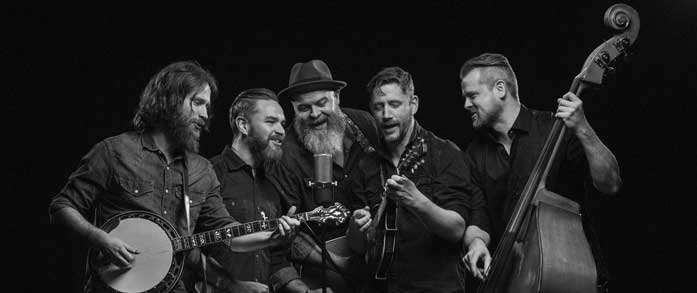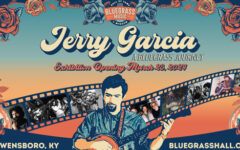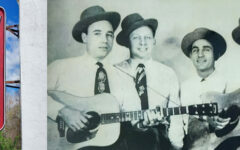
Matias Hilmar Iversen offers a superb example of how music can breach boundaries and find a common connection regardless of locale. His band, Ila Auto, has won myriad awards and an impressive following in their native Norway, having performed over 1,200 shows since the band initially formed in 2005. To date, they’ve played several of the biggest music festivals in that country — Øya, Molde Jazz, Slottsfjell, Kongsberg Jazz, and Vinstra Country, among the many.
Nevertheless, their fame isn’t limited to their native environs. They’ve appeared at the European World of Bluegrass (EWOB) in the Netherlands twice, the Bluegrass Festival Bühl in Germany, and various gatherings in Denmark and Sweden.
Originally from an area near Oslo, the members — Iversen (vocals, guitar, harmonica), Are Fevang (vocals, dobro, national steel), Kay Arne Sulutvedt (banjo), Kai Henrik Ryen (mandolin, vocals, snaredrum, washboard), Karl-Joakim Wisløff (bass, vocals) — now live in various parts of the country. The band was founded by Iversen and his younger brother Kristoffer, along with cousins, Fevang and Sulutvedt. The year after, Ryen, a classmate from university, joined the group and Ila Auto began taking shape. “We quickly started to play concerts after a few rehearsals and were very well received,” Iversen recalls. “We got more gigs than we had with any of our previous bands, none of which were bluegrass bands. We kind of struck gold by falling in love with the genre.”
Il Auto has been unstoppable ever since, Iversen says. “We released our first record, If You Keep Pickin‘, It Might Never Heal, in 2006, and the album went on to win Spellemannsprisen, the Norwegian equivalent of the Grammy Award. Since then, we have released five albums — 2008’s Over the Next Hill, which was also nominated for that award, a self-titled effort in 2010, Liker ikke Køntri in 2014, an EP, Pent Brukt, in 2016, and, most recently, Piknik med Døden, in 2020. That year, Kristoffer left the band and was replaced by Karl-Joakim.”
The band’s music can be heard on most streaming services, and they’ve produced several successful videos as well. And while they draw their sound from the rustic roots of Appalachia, they’ve made it a point to keep their own cultural connection intact as well.
“The first two albums are in English, but from 2010 we started to sing and write in Norwegian,” Iversen explains. “There is something about writing in your own language that just sounds better to us than ‘English-as-second-language’ lyrics. It might not be ideal for a break-through on the global bluegrass scene, but for us it works just fine. We’ve even had success playing our Norwegian songs live in Germany and Switzerland, even though they probably don’t understand what we’re singing.”
Iversen describes the band’s essential sound as plied from guitar, mandolin, dobro, banjo, bass, and three part harmonies. “It’s direct, big, and warm… and a bit rowdy, especially live,” he says. “We play bluegrass, but kind of act like it’s rock and roll. Plus, we have always strived to have a unified sound, meaning that the band sounds like it’s all one instrument. For some recordings, we add fiddle to our core sound. We have also used electric guitars, and even organ on some of our albums. We’re not necessarily purists, but we always return home to the basic bluegrass instrumentation. That is where the heart is.”
As Iversen indicates, the members of the band claim different musical backgrounds and approaches that vary, from old-timey blues, jazz, singer/songwriter influences, stoner rock, indie rock, and even marching bands. He lists their early bluegrass influences as Bill Monroe, and Flatt & Scruggs in particular, as well as Del McCoury, Ricky Skaggs, Tony Rice, and Union Station, among others.
Happily then, they’ve had the opportunity to share stages with a number of well-known artists. “One of the best memories is from Bühl Bluegrass festival in Germany in 2018 where we had the chance to jam with Sierra Hull after the show,” Iversen recalls. “We have also played support for the band Hayseed Dixie.”
So too, he says that band has been well received by those back home. “We take great pride in performing live, and we always try to give something extra,” he insists. “At music festivals in Norway, we often present something unexpected and different for the audience. We were among the bands who started a sort of revival of bluegrass music and country music in the mid 2000s.”
In that regard, the band put their focus mostly on the original material he writes and which is then arranged by the band. However, they also include covers in their repertoire — among them, My Saro Jane by Flatt & Scruggs, Red Clay Halo from Gillian Welsh, Joy McKean’s Lights on the Hill, the Shel Silverstein song, Long Time Working it Out, and the traditional tune, Wayfaring Stranger.
Ultimately, Iversen has his own theory as to why bluegrass enjoys such worldwide popularity.
“Bluegrass is real, you can’t fake it,” he maintains. “We believe bluegrass is music for everybody, regardless of age, musical preferences, or one’s origins. It doesn’t matter how sad you are — the sound of banjo and three piece harmony will make you smile. Our fourth album is Liker ikke Køntri, which means, ‘I don’t like country music.’ This is a comment we often get when we play at a rock festival or something similar— ‘I don’t like country music, but this was actually great!’ We think that this says a lot about bluegrass music and the way it connects with a broad audience.”







